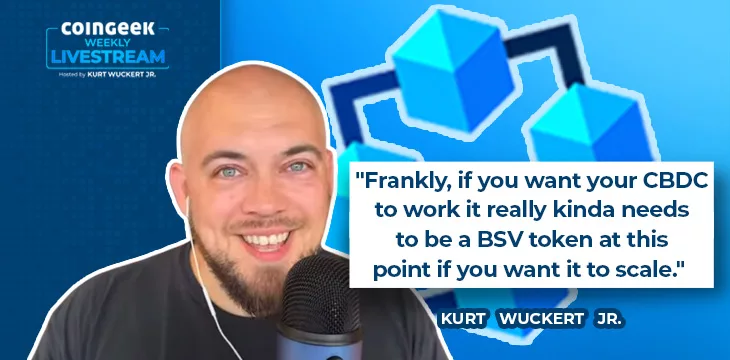|
Getting your Trinity Audio player ready...
|
On the first episode of the CoinGeek Weekly Livestream season four, Kurt Wuckert Jr. fielded viewer questions on anything and everything about Bitcoin.
How challenging is it for a BTC or BCH miner to switch to BSV?
Wuckert says there are a few conceivable ways this could happen. One way is to join a pool like GorillaPool. The other is to run your own node infrastructure like Mining-Dutch does. This firm’s algorithm detects where it’s most profitable to mine and switches hash power accordingly.
In any case, the first step is to sync up a BSV node. This can be done at BitcoinSV.com, where you can download the client. Wuckert says this can be time-consuming due to the size of the blockchain, which is now eight or nine terabytes. How long are we talking? It could be weeks if you’re starting from scratch.
Is Epstein behind the SegWit soft fork? Any comments on the Satoshi 0 block receiving 27 BTC?
Epstein isn’t behind the soft fork, but he was a financier who laundered money through a company called Digital Garage. This firm had links to the Digital Currency Initiative at MIT. Significant BTC developers, including Cory Fields and others, were involved in the initiative. In summary, he had his fingers in it to a degree, but he wasn’t directly behind it. It’s tough to directly answer how much influence financiers have and how they wield it.
As for the 27 BTC to the Satoshi block, we don’t know. Anyone can send BTC to Satoshi addresses. While there has been some speculation it is Dr. Craig Wright, Wuckert finds this unlikely given it originated on Binance.
Are nChain’s patents a significant reason all CBDCs are just at the testing stage?
Wuckert walks us through the process of what a central bank looking to issue a central bank digital currency (CBDC) is likely to do. They’d hire a blockchain consultancy firm who’d almost certainly recommend a blockchain like Ethereum or Solana. They may come across BSV and almost certainly come across patents during their due diligence.
Wuckert has heard that nChain is working with some governments on related projects. However, he can’t confirm this since he’s not an nChain insider. In any case, if you want your CBDC to work and scale, it will have to be tokenized on BSV.
Later, a viewer noted that the EU will test a CBDC in Q3 2024, and he wondered what this might mean for BSV. Wuckert reiterates that they’ll end up on BSV no matter where they start. It’s the only one that scales.
Are Bitcoin ETFs a threat to network security?
“Absolutely,” Wuckert answers. He wrote about how Bitcoin has gone from being a challenger to the financial system to something BTC advocates are hoping the banks buy so they can get more fiat gains.
Both paper Bitcoin products and big firms like BlackRock controlling too many coins could be problematic. Either puts big players in a position to manipulate it while making fees. We’ve seen similar behavior with the Grayscale Bitcoin Trust (NASDAQ: GBTC).
Wuckert goes further, saying all this speculation has already been an attack on Bitcoin. Everyone is so focused on “number go up” that they’ve ceased thinking about blockchain technology.
Why have BTC and BSV got different numbers of coins issued?
Part of it is a bug introduced when BCH split from BTC; there was a bug in the difficulty adjustment algorithm. As a result, a lot of blocks happened extremely quickly. Weeks’ worth of blocks occurred in a couple of hours, and BSV inherited that after splitting from BCH.
To learn more about Teranode progress, the true nature of the Genesis block, and why hard money must be unchanging, listen to the podcast via the link at the top of the page. Make sure to subscribe to CoinGeek.com for alerts about the next episode and for more content like this.
Watch: Most people don’t understand Bitcoin

 07-11-2025
07-11-2025 





